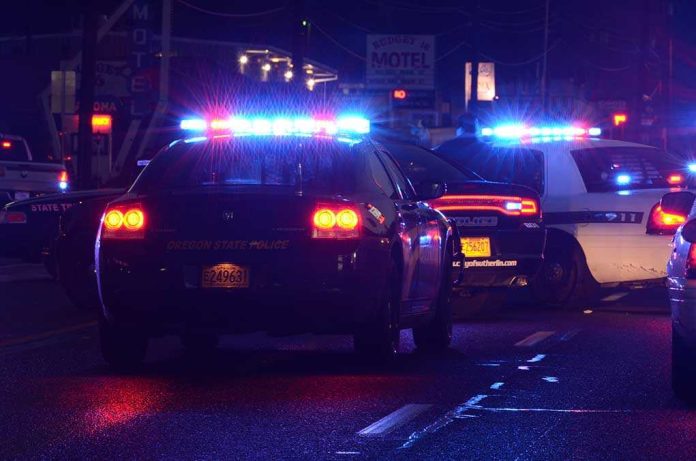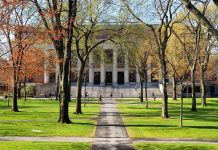
Two groups unleashed a hail of gunfire in Montgomery’s bustling nightlife district—leaving families shattered, a city shaken, and a nation once again questioning how communal celebration can so swiftly turn to chaos.
Story Snapshot
- Mass shooting erupts after a football game in downtown Montgomery, Alabama, killing two and wounding fourteen.
- The tragedy unfolded amid a packed tourism weekend, amplifying both risk and devastation.
- Multiple shooters, bystanders caught in crossfire, and no arrests highlight deep public safety challenges.
- Authorities and community leaders grapple with fallout, demanding answers and accountability.
Gunfire in the Heart of a Celebration
Saturday night should have been a highlight for Montgomery—alumni reunions, a classic football rivalry, and a city center booming with fairgoers and homecoming crowds. Instead, the night fractured at 11:30 p.m. as gunshots ripped through the downtown district. Police converged on a chaotic scene: two people dead, fourteen injured, and the bitter taste of terror lingering over what should have been a jubilant weekend. The violence didn’t erupt inside any official event, but in the crowded artery where celebration, commerce, and community converge. Shooters acted with staggering disregard for innocent life, firing into a mass of locals and visitors—some armed themselves, most simply caught in the wrong place at the wrong time.
As first responders worked through the confusion, the scope of the carnage became clear. Among the dead: Jeremiah Morris, just 17, and Shalonda Williams, 43. Of the injured, at least seven were under 20 years old, a sobering testament to how the reverberations of violence cut across generations. The mayor and police chief delivered grim updates, their words tinged with anger at the recklessness that had upended so many lives. Press conferences the following day offered little solace—no suspects in custody, no clear motive, and a community left to mourn and fear that tragedy could strike again just as suddenly.
Montgomery’s Ongoing Struggle with Public Safety
Montgomery’s downtown has been a symbol of revitalization, drawing crowds to new restaurants, music venues, and vibrant festivals. Yet, the city’s history with gun violence is never far from the surface, especially when high-profile events bring thousands together in tight quarters. The Tuskegee-Morehouse Classic, a marquee football rivalry, was just one of several events that swelled the city’s population that weekend. Law enforcement faced an unenviable task: securing streets teeming with revelers, managing disparate crowds, and anticipating trouble that could spark from almost any corner.
Rival gunmen started shooting at each other in a crowded downtown nightlife district in Alabama's capital city Saturday night, killing two people and injuring 12 others, police said. https://t.co/lTjJmWfVHX
— CBS News (@CBSNews) October 5, 2025
Previous years had demanded heightened security, but the convergence of a football classic, a university homecoming, and the state fair created a perfect storm of logistical challenges. The shooting site, blocks from the main venues, underscores how violence often finds the gaps—spaces where authorities can’t be everywhere and where split-second disputes can escalate beyond control. The police, now working with state and federal partners, have recovered multiple weapons and shell casings, but the investigation remains hampered by the chaos and the sheer number of people present when bullets began to fly.
Community Fallout and the Search for Accountability
City leaders have moved quickly to condemn the violence, determined not to let one night’s horror define Montgomery’s reputation or its future. Mayor Steven Reed promised not to “normalize” such incidents, echoing the frustration of residents and business owners who fear that continued violence could undo years of progress. The economic and social stakes are high: local businesses depend on the steady influx of tourists, and community pride hinges on the safe enjoyment of shared spaces. Every mass shooting leaves visible and invisible scars, but when the victims include so many young people, the wounds feel especially deep and the calls for change more urgent.
Law enforcement officials face mounting pressure to solve the case, restore public confidence, and prevent future tragedies. With five victims still hospitalized in critical condition, the ripple effects will last long after headlines fade. Some community voices demand stricter gun laws, while others focus on deeper social investments to address the roots of violence. What unites nearly everyone is the recognition that the cost of inaction is too high—and that the next celebration cannot come with the same sense of dread.
Expert Perspectives on Prevention and Recovery
Public safety analysts and law enforcement experts stress the acute dangers of large gatherings where rival groups, often armed, may cross paths in unpredictable ways. Effective crowd control and proactive policing have become more challenging as nightlife districts grow and social tensions simmer just below the surface. Event security consultants point to the need for coordinated planning and real-time intelligence, especially when multiple major events overlap. Sociologists, meanwhile, warn that the intersection of youth culture, easy firearm access, and dense crowds is a volatile mix—one that demands solutions beyond the reach of law enforcement alone.
The path forward is fraught with debate. Some leaders argue for immediate, visible changes—metal detectors, bag checks, more police on foot. Others urge a broader reckoning with why disputes among young people can so quickly escalate to deadly force. What is clear: Montgomery’s latest tragedy is neither isolated nor inevitable. With each headline, the conversation about gun violence in American public spaces becomes more urgent, more personal, and, for the families left behind, more heartbreaking. The question is whether this time, the shock and sorrow will translate into sustained change—or just another entry in a long, grim ledger of preventable loss.



